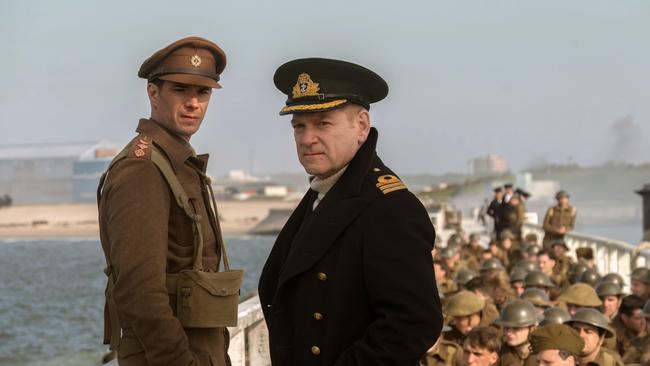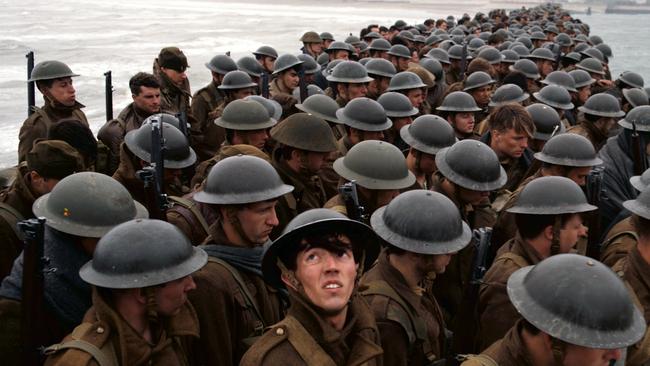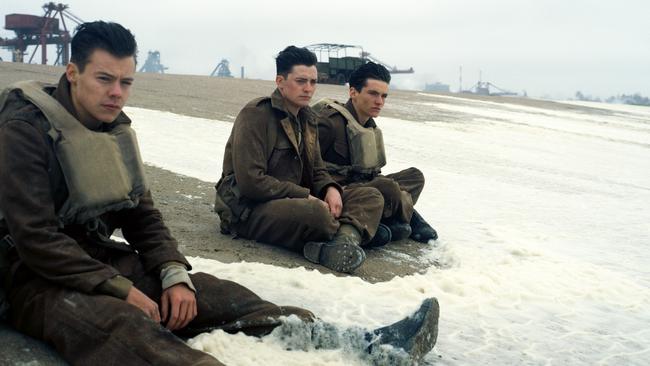Dunkirk, with Harry Styles and Kenneth Branagh, a top-shelf war film
Dunkirk is a war film that is not a war film, yet will immediately enter the ranks of the best war films made.

“You can practically see it from here,’’ says Commander Bolton, the highest-ranking officer on the sparse white beaches of Dunkirk. “What?’’ asks a soldier. “Home.”
Home. That is the anchor of Christopher Nolan’s remarkable Dunkirk, a war film that is not a war film and yet will immediately enter the ranks of the best war films made so far.
I walked out of the VMAX screening — and this is a movie that must be seen on a large screen — thinking it deserved 4½ stars. The next morning I decided on five.
This score does not mean it’s perfect. What film is? But it is movie-making at the highest level. The last film I thought on the cusp of five stars was Richard Linklater’s Boyhood in 2014. Before that, Terrence Malick’s The Tree of Life in 2011, though I did not review it.
Dunkirk in northern France is 26 miles — as the British measure it (42km for us) — from England. It is 10km from the Belgian border.
As the Germans blitzed Europe in the opening months of World War II, about 400,000 soldiers, most of them British but including some French, Belgian and Canadian troops, were stranded at Dunkirk, “fish in a barrel”, as one puts it in this film, for the Luftwaffe.
The evacuation of Dunkirk took place from May 26 to June 4, 1940. It involved more than 900 ships, including lots of small craft, some crewed only by civilians. On June 4, Winston Churchill, prime minister for 16 days when Operation Dynamo started, made his famous “we shall fight them on the beaches” speech. The line that is less often quoted is his warning that “wars are not won by evacuations”.
London-born Nolan is a deliberate director. Everything that is in one of his movies is there for a reason, as is everything that is not. Dunkirk excels on both counts, but it is the second that I keep thinking about.

The war is eight months old. Here are some of the people we never see or hear: Churchill, Adolf Hitler, politicians, war room generals. We do not see German soldiers (until a brief final scene) or hear the word Nazi. They are “the enemy”. The valiant rearguard troops, mostly French, are not in the mix. We do not see much blood, unlike say Mel Gibson’s fine World War II drama Hacksaw Ridge, and yet the building tension and constant fear is almost unbearable.
There is little dialogue. There is no backstory for any of the characters; not one, which is something I don’t think I’ve seen in a war movie. We don’t know where they come from, beyond their country (and that twists towards the end). Often we don’t know their names.
Character development is minimal to the point of non-existent. That’s not a complaint. This is one almost unimaginable week in the lives of men we do not know, told in 106 minutes. When we do learn a tiny bit about a few of them near the end, particularly the civilian sailor Mr Dawson, it is realistically simple and deeply moving. I haven’t mentioned the actors because this film is so immersive it’s almost as though they are not there. It is the young soldiers who are there, unhardened boy-men who do not yet know, as we do, the future enormity of this war. We care about them. With the exception of the outstanding Kenneth Branagh as Commander Bolton, the actors are hard to see.
The lead, if there is one, is a private named Tommy (20-year-old Fionn Whitehead in his film debut). Star singer Harry Styles is another private, Alex. Cillian Murphy from Peaky Blinders is a near-mute shell-shocked soldier with no name. The quietly commanding Mark Rylance is Mr Dawson, a tie under his jumper. That chameleon Tom Hardy is a Spitfire pilot, so we rarely see his face and when we do it’s masked. The only women are nurses. This is a male-dominated film. This war is man-made.
All of these absences are there for Nolan’s reasons. He did not want to make a sentimental movie, or one defined by heroism. He didn’t want to make one about a victory. This is about the soldiers stranded on a beach and the civilians who helped rescue them.
The absences also counter one of the challenges in making a movie about such a well-known historical moment. Anyone who paid attention at school knows that Dunkirk is one of the largest military evacuations in history. But it’s not the result that matters here. It’s the days, hours, minutes on the sand, on the pier, in the water, in the sky. This time is precious and perilous. Quiet moments are harrowing, such as when Tommy and two mates sit on the beach and watch, without reaction, another soldier wade into the sea, seeking oblivion.
So are the action scenes, especially an extended one that parallels a group of soldiers going underwater on a bullet-riddled small boat and a Spitfire pilot going underwater in his downed plane. Hans Zimmer’s heart-thumping score underpins every moment.
Nolan has a fascination for blurring time and memory, points of view and identity. As a cinematic technique this perhaps reaches its high point in his mind-boggling 2000 film Memento, starring Australia’s Guy Pearce. Here it is more subtle but dramatic and poignant. Mr Dawson’s perception of the Spitfire hitting the water is not the same as the pilot’s, and the difference is amazing to watch.

Nolan tells the story from three perspectives: land, sea and air. There is some repetition and this, too, is quite deliberate. It underscores the endlessness of what the men are enduring, an endlessness that could end in a second. Cinematographer Hoyte van Hoytema shot most of the movie, location Dunkirk, on IMAX 65mm film and the result is spellbinding.
The aerial battle scenes feel so real that viewers will check under their armrests for the cockpit release lever. Hardy’s pilot is calm, certain, doing what he knows he has to do. There is no bluster, no cheering, no jokes. We see how hard it was for a plane to shoot down another plane, the sort of reality war films often avoid. Similarly, at sea, we see how quickly boats can sink when bombed or torpedoed. Nolan was able to put into the film 12 boats that were there at Dunkirk in 1940, historical vessels now. I suspect these ones were not torpedoed.
The behaviour of the men on the beach is also unlike what we are used to seeing on the screen. They wait in queues, patiently, in Brodie helmets and combat gear, for boats to take them home. When the Stukas drop bombs the soldiers huddle on the sand or pier or, if on the sea, dive into the oily water. What else can they do? There is nowhere to go. They are men who follow orders, yet sometimes their raw humanness, their need to survive, comes out. One scene, where some soldiers decide one man must be sacrificed so the rest can live, took me back to William Golding’s Lord of the Flies.
Nolan, 46, is the sixth highest-grossing film director. He has made the best Batman movie, The Dark Knight, and sophisticated sci-fi films such as Inception and Interstellar.
He might not be the first director who comes to mind for a war film. Nor is the highest-grossing director, Steven Spielberg, yet he made one of the best, Saving Private Ryan, as well as Schindler’s List. Nor is Stanley Kubrick, who made two masterpieces 30 years apart, Paths of Glory (1957) and Full Metal Jacket. Like them, Nolan has used an outsider’s intuition to create something that will live inside viewers.
Dunkirk (M)
5 stars
National release


To join the conversation, please log in. Don't have an account? Register
Join the conversation, you are commenting as Logout